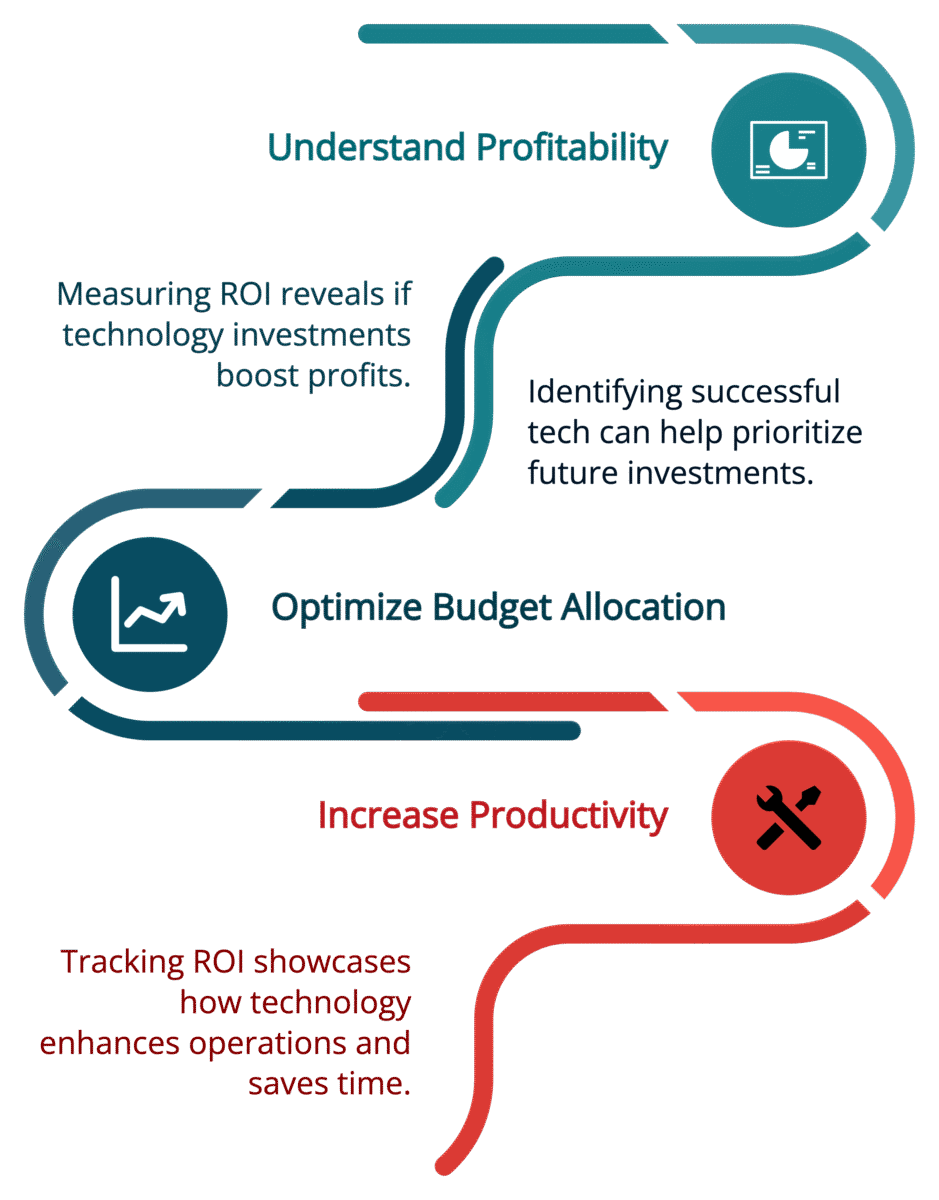
Technology ROI: How to Know If Your Tech Investments Are Worth It
Investing in technology can be exciting. New tools promise to save time, boost productivity, and grow your business. But how do you know if the money you spend on technology is actually paying off? That’s where Technology ROI (Return on Investment) comes in.
Thank you for reading this post, don't forget to subscribe!What Is Technology ROI?
Technology ROI is a way to measure whether the money you spend on technology is worth it. In simple terms, it compares what you spend on a tech tool to the benefits you get from it.
Here’s the basic formula:
Technology ROI = (Benefits Gained – Cost of Technology) ÷ Cost of Technology
If the number is positive, your investment is paying off. If it’s negative, you might be losing money.
Why Does Technology ROI Matter?

Technology is a powerful tool for businesses, but it comes at a cost. Whether you’re investing in new software, upgrading equipment, or automating tasks, you need to know whether the investment is actually improving your business. Technology ROI (Return on Investment) helps you measure that.
If you don’t track ROI, you could end up wasting money on tools that don’t add value, slowing down productivity, or even hurting your bottom line. On the other hand, a positive ROI means your technology is working for you, not against you.
What a Good ROI Means for Your Business
If your technology investment has a good ROI, it’s delivering measurable benefits. That could mean:
1. You’re Saving Time or Money
Technology should make work easier, not harder. Automation tools, for example, reduce manual tasks, freeing up employees to focus on higher-value work. If an AI-powered chatbot handles customer service inquiries, your staff can spend less time answering common questions and more time solving complex problems.
Benefit to You: Your team is more productive, and you save on labor costs.
2. You’re Increasing Efficiency
Good technology speeds up processes and improves workflows. A project management tool, for example, helps teams stay organized, track progress, and communicate better. If employees can complete tasks faster and with fewer errors, your business becomes more efficient.
Benefit to You: Projects get done faster, with fewer mistakes, and team collaboration improves.
3. Your Revenue Is Going Up
Certain technologies help directly increase revenue. E-commerce automation, for instance, can personalize marketing campaigns to drive more sales. CRM software helps businesses better track and convert leads. If you see a boost in sales after implementing a new tool, that’s a clear sign of a strong ROI.
Benefit to You: Your business makes more money without significantly increasing costs.
What a Bad ROI Means for Your Business
If your technology investment has a poor ROI, it’s costing you more than it’s helping. Some warning signs include:
1. You’re Spending More Than You’re Earning Back
Sometimes, a tool sounds great on paper but doesn’t deliver in reality. For example, a marketing automation platform might cost $1,000 per month, but if it only brings in $500 in additional sales, it’s not paying off.
Problem for You: Instead of growing your business, the technology is draining your budget.
2. Employees Aren’t Using the Tool Effectively
No matter how good a tool is, it’s useless if no one uses it. A CRM system that employees find too complicated won’t provide value because data won’t be entered correctly or consistently.
Problem for You: If employees avoid or misuse the tool, you won’t see the intended benefits, and productivity could actually suffer.
3. The Tool is Slowing Things Down Instead of Speeding Them Up
Technology should streamline operations, not create bottlenecks. If a new inventory management system is difficult to use or causes delays, it could result in more frustration and lost time rather than efficiency.
Problem for You: Instead of increasing productivity, you end up wasting time and money trying to make the system work.
Why Tracking Technology ROI Helps You Make Smarter Decisions
![]()
Measuring ROI isn’t just about deciding whether to keep or cancel a tech investment. It also helps you:
- Choose the right tools. Before buying, you can compare options and pick the one with the highest potential return.
- Improve adoption and training. If ROI is low because employees aren’t using the tool, training can fix the issue.
- Optimize your investments. By tracking ROI, you can adjust how you use a tool to get better results.
Bottom Line: Technology should make your business stronger, not weaker. Tracking ROI helps you invest in tools that actually work and avoid wasting money on those that don’t.
ROI Calculation Methodology & Common Challenges in Technology ROI
Investing in technology can improve efficiency, reduce costs, and boost revenue. However, calculating Technology ROI (Return on Investment) can be tricky. Many businesses struggle to measure whether their tech investments truly pay off.
This guide explains how to calculate ROI for technology and highlights common challenges businesses face when trying to measure it accurately.
How to Calculate Technology ROI
Technology ROI is the ratio of the financial benefits gained from a technology investment compared to its total cost. The basic formula looks like this:
Technology ROI = (Net Benefits – Cost of Investment) ÷ Cost of Investment
A positive ROI means the technology is delivering value, while a negative ROI suggests a loss.
1. Identify Total Costs
To get an accurate ROI, calculate all expenses related to the technology, including:
- Initial Purchase or Subscription Fees: The cost of buying or subscribing to the software or hardware.
- Implementation and Setup Costs: Fees for installation, integration, or migration from an old system.
- Training Costs: Time and money spent on employee training.
- Maintenance and Support Fees: Ongoing costs for updates, customer support, and troubleshooting.
2. Measure Financial Benefits
To justify a technology investment, businesses must quantify the value it provides. Common benefits include:
- Revenue Growth: Increased sales due to improved customer experiences or marketing automation.
- Productivity Gains: Time saved by employees using automation tools or better software.
- Cost Reductions: Lower operational expenses, such as fewer manual processes or reduced error rates.
For example, if an automated invoicing system costs $1,000 per month but reduces labor costs by $3,000, the financial benefit is $2,000 per month.
3. Apply the ROI Formula
After determining total costs and financial benefits, apply the ROI formula.
Example Calculation:
- Investment cost: $5,000
- Annual financial benefit: $10,000
- ROI = (10,000 – 5,000) ÷ 5,000 = 1 or 100%
An ROI of 100% means the investment has doubled its cost in returns.
Common Challenges in Technology ROI Calculation

Measuring technology ROI is not always straightforward. Many businesses face obstacles that make it difficult to get an accurate assessment.
1. Difficulty in Measuring Intangible Benefits
Technology investments often provide indirect benefits, such as improved employee morale, better customer experience, or enhanced brand reputation. While valuable, these factors are difficult to quantify in monetary terms.
2. Delayed ROI Realization
Some technology investments, such as enterprise software or AI-driven analytics tools, may take months or even years to show measurable benefits. Businesses that expect immediate returns may miscalculate the actual ROI.
3. Inconsistent Usage of Technology
If employees do not fully adopt a new tool, its expected benefits decrease. Poor training, resistance to change, or lack of integration with existing systems can lead to lower ROI than projected.
4. Hidden or Unexpected Costs
Many technology investments come with additional costs that businesses overlook, including:
- Licensing fees for additional users
- Costs of upgrading hardware to support new software
- Unforeseen maintenance expenses
These extra costs can reduce the actual ROI of an investment.
5. Lack of Clear ROI Tracking Metrics
Businesses often struggle with tracking ROI because they lack clear metrics. Without proper before-and-after comparisons, it becomes difficult to determine whether a technology investment is paying off.
How to Overcome Technology ROI Challenges
To improve accuracy when calculating ROI, businesses can take several steps:
- Set Clear Objectives: Define the key performance indicators (KPIs) that will determine success. These could include time saved, revenue generated, or cost reductions.
- Conduct Pilot Tests: Before full-scale implementation, test the technology with a small team to measure its impact.
- Monitor ROI Over Time: Track performance data over months or years to see long-term benefits.
- Improve Employee Training: Ensure staff understands and fully utilizes the technology to maximize its potential.
How to Measure Technology ROI
Measuring ROI doesn’t have to be complicated. Follow these steps:
1. Identify the Cost of Technology
Add up everything you spend on the tool. This includes:
- Purchase price or subscription fees
- Setup and training costs
- Maintenance or support fees
2. Measure the Benefits
Look at how the technology improves your business. Does it:
- Save employees time?
- Increase customer satisfaction?
- Boost sales?
Try to put a number on these benefits. For example, if a tool saves an employee 5 hours a week, that’s 20 hours a month. Multiply that by their hourly wage to see how much money you’re saving.
3. Compare Costs and Benefits
Use the ROI formula to see if the benefits outweigh the costs. If a $500 tool saves you $2,000 in labor costs, your ROI is positive. If it only saves you $300, you might be losing money.
Examples of Good & Bad Technology ROI
| Technology | Cost | Benefit | ROI |
|---|---|---|---|
| Automating customer service with AI | $1,000/month | Saves 50 hours/month ($2,500) | Positive ROI ✅ |
| New project management software | $500/month | No one uses it, no real benefits | Negative ROI ❌ |
| Upgrading office computers | $5,000 (one-time) | Increases work speed by 20% | Positive ROI ✅ |
How to Improve Technology ROI
If your tech investment isn’t paying off, don’t panic. Here are some ways to improve ROI:
- Train your team. A great tool is useless if no one knows how to use it.
- Start small. Test a tool with a small team before rolling it out company-wide.
- Track results. Keep an eye on time savings, customer feedback, and revenue increases.
- Choose wisely. Don’t buy tech just because it’s trendy. Pick tools that solve real problems.
Technology can be a game-changer for your business—but only if it actually delivers value. Before investing in new tech, do the math. If the numbers don’t add up, it might not be the right choice.
Want to make smarter tech decisions? Track your ROI, adjust when needed, and always focus on solutions that truly help your business grow.


